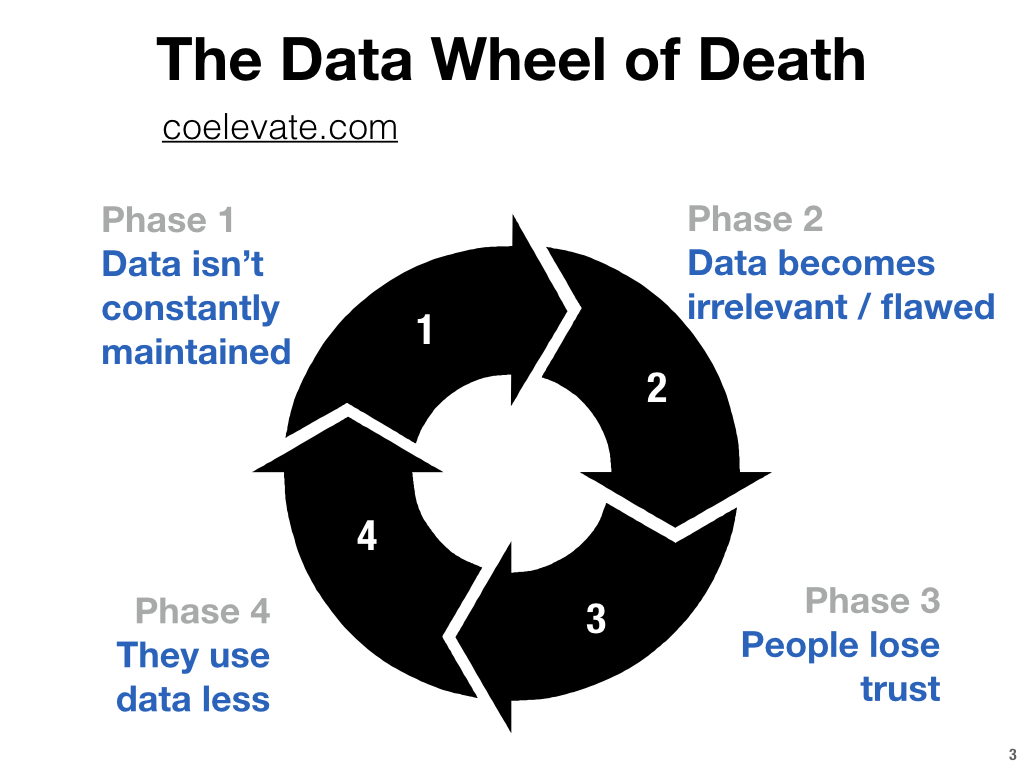Speed is key
This one might seem trivial but it is not. As data analysts we perform several steps:
- Getting relevant data
- Data cleaning and preparation
- Summarizing data
- Visualizing the findings
- Communicating these findings in an inspiring way, so that others can make better decisions
Obviously, being quick at performing each step is important. But what matters the most is how fast one can reach the final step, which is getting people to take action based on data. For example, if I make a report that no one reads in 30 minutes, I never reach this final step. Then, I am not doing a good job. But if I take 2 hours for the same request, including the “marketing time” and get one person to act on the insights in this report, I am doing way better!
Stay up to date
The IT world in general moves fast. New languages, tools or frameworks make older ones look incredibly inefficient. It is the same as a data analyst. A new tool or Python library can trivialized parts of your work. And make you way more efficient in a matter of minutes! So, don’t live in the past, get to know what’s current.
Stand on the shoulders of giants
Let’s be honest, unless you are doing some cutting edge work, the problem you are working on has already been solved by someone else. 3 years ago. More efficiently. All you need to do is finding where is this solution, understanding it and implementing it. That’s what I love about the analytics and computer science community. And now that Python is the most popular programming language, you don’t have any excuse!
Standardize and automate
If you are not doing exploratory data analysis, you should be able to standardize the way you process requests. Formalize how you get and clarify requests, establish control mechanisms, write documentation. The usual things… I believe that everything which can be done better by a computer, should be done by a computer. This way, it frees up time to work on tasks creating more value. I personally automate things because of a compulsive disorder I got from a teacher, but that’s another thing. Automation is a key skill in data science. Better be the one automating the work of others, right? I think we shouldn’t fear it, but it’s the topic of another post.
Self-service analytics
The dream of all analytics departments, allowing users to find the answer to their repetitive requests themselves! However it can only be done under certain conditions. First, your data game needs to be on point (see the pyramid below). You need to reach a level of structure and standardization where you can be certain that a user will find an accurate information if he/she uses your tool correctly. Second, well you need to make sure they actually use the tool correctly. There is a large amount of UI/UX design, internal promotion and training to be done to reach this point.
Get support and engagement
There is a vicious circle in analytics:

Break it! Get people interested and invested in analytics. Spend time maintaining your data warehouse, ensuring everything is captured, etc. These boring tasks are really the groundwork you need. Once again, it is about people using data, not developing fancy stuff. Simple KPIs consistently used will get you a long way. On the other hand, a model people believe to be wrong does you no good.
Be proactive
In a dream world, the good ideas come only top-down. Just kidding, it would be a complete nightmare. What is for sure is that business people have business problems. Then you need to do some work to phrase these problems and translate them into technical problems. All of that is just the basics, in my opinion. it gets interesting when you start to be on the lookout for people having issues they are not yet able to phrase with words or simply unmet needs. Another thing: people are limited in their requests by their imagination. Show them all the wonders you can do and it will supercharge their ideas!
Data science hierarchy

The data science equivalent of Maslow’s pyramid of needs. Same concept, try to skip steps and you will fall back down. This hierarchy provides a clear structure for what to do first and why. The tricky part is to stick to this structure. Let’s say you start from the bottom and you decide to focus on collecting data. After a few weeks you are asked to provide metrics. You try to argue your way out but you end up doing the work. Your organization is happy and asks for more. Now you need to build the foundations as you climb or build a house of cards.
Empower users
In the end, the purpose of all self-service analytics tools is to empower business users so they can get the answer to their own data-related questions. I don’t think the empowerment should be limited to using a tool giving pre-processed results. It is also about teaching best practices, explaining capabilities, being more proficient with a computer in general. You probably use it for 8 hours a day, it would make sense to know more about it, right?
Conclusion
My take is that being a good data analyst is about balancing technical skills, domain knowledge, a sense for marketing your work, understanding the users and be willing to learn.